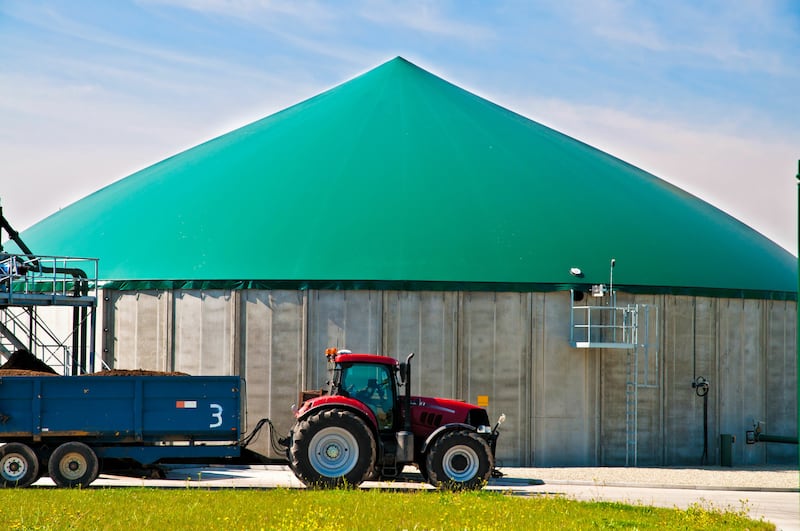The natural gas many of us use to heat our homes and cook our food is the result of the breakdown of organic substances from millions of years ago, which became trapped in rocks deep underground and under the sea. Drilling and extracting that gas became a massive industry, and it continues to be. Indeed, natural gas became such an Irish success story that back in the 1980s, Kellogg’s Corn Flakes gave away a model kit of a Kinsale gasfield drilling rig for kids to assemble. Imagine that happening today.
While natural gas is, relatively speaking, a “clean” fossil fuel, a fossil fuel it most certainly is and burning it has a significant carbon cost. However, much of our home heating infrastructure is currently predicated around gas supply, and that won’t be an easy thing to replace. But what if we could make a carbon-neutral gas which could be fed into the same pipes and boilers, enabling emissions-free (or at least emissions-balanced) heating and cooking?
Well, we can. We can make biomethane (methane is essentially the bit of natural gas that burns) by filling up anaerobic digesters with farm waste, waste food, grass clippings, and even animal manure. Leave all of that to digest for a while and it will naturally start to emit methane which can be captured, purified, and eventually fed into the same pipes as regular natural gas.

A recent study by the non-profit organisation South East Energy Agency (SEEA) suggested that as much as 47 per cent of the energy needs in the southeast region could be met by bio-compressed natural gas (CNG) produced by just such a process.
READ MORE
“We see two clear pathways for the southeast,” says Paddy Phelan, chief executive of SEEA. “While bio-CNG refuelling stations would support heavy goods vehicles in the shift to low-carbon transport, this locally produced green gas solution also provides a direct and affordable way for SMEs and public sector entities to decarbonise their heating systems. By replacing old oil or gas boilers with a new gas boiler commissioned to burn green biomethane, businesses and public sector facilities can immediately cut their carbon emissions as we’ve seen at Wexford Fire Station and Kilkenny Machinery Yard Depot.”
How viable an idea is this, though? Should Irish farmers be filling up biodigesters and putting in their membership applications for Opec? Well, maybe not just yet. There’s a balance to be struck.
Official Government guidelines suggest that eventually we could produce around 5.7 terawatt hours’ (TWh) worth of biomethane, which would account for somewhere between 10 and 20 per cent of total gas demand in Ireland. To get there might require significant industrialisation of the whole process though.
“In Belgium, they have really industrialised the process” says Stephen Prendiville, an expert on sustainable innovation and investment with Deloitte. “There is a tension that comes in when you start to ask what kind of agriculture do we have in this country and what is the optimum point for decarbonisation of that industry? I think for individual farms and farmers, getting big into biomethane on their own would be difficult, as there are significant investments needed, but perhaps at the co-op level it could work much better, bringing together groups of farms and farmers.”

Russell Smyth, head of sustainable futures at KPMG, reckons that there is a route for farmers to get maximum returns from biomethane. “Bio-methane offers a unique opportunity for farmers to diversify their income by entering into long-term feedstock contracts, land leases and taking ownership stakes in biomethane production facilities,” he says.
“While plants will use a variety of feedstocks, it is expected that agricultural crops and waste streams will be the dominant input. The National Bio-methane Strategy envisages that approximately 140 anaerobic digester plants, producing around 40-gigawatt/hours of biomethane each, will be required to hit the indigenous production target of 5.7TWh. While this target is ambitious by design, industry appetite is strong, with nearly 30 developers submitting applications for a recent Department of Agriculture capital grant scheme.”
There’s a further bonus, says Prendiville: “The extra nuance that comes into this is energy security. So domestically producing a “green” gas such as biomethane, if you think of the sustainability and security of that, it adds to the decarbonisation aspect.
“What we have to be careful of is to ensure that we’re creating the right kinds of market mechanisms so that competition should produce the best result of all but that it’s definitely the result that we want and that we need. As part of that, there’s a trajectory that we have to follow with agriculture, but we need to have an honest conversation about land use and allocation and how we structure all of that.”














